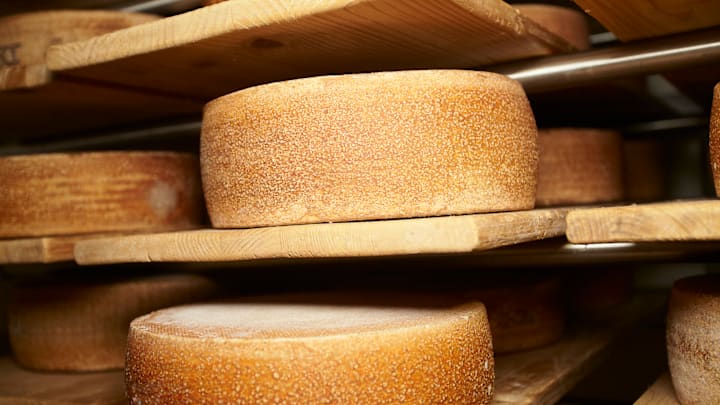Of the various issues that have raised the ire of politicians over the decades, one in particular prompted a strong rebuke in 1981: Moldy cheese.
That year, Secretary of Agriculture John Block hefted a brick of fungus-infested processed cheese in the hallowed halls of the White House to demonstrate a pressing concern over dairy subsidies and their calamitous effects. “We don’t feel we can keep the oldest cheese much longer,” he said.
Iowa congressman and dairy advocate Tom Harkin cried foul. “Shame,” he said during a House debate on a farming bill. “Shame on Secretary Block for bringing out moldy cheese.”
The bitter cheese imbroglio of 1981 was part of a larger dairy issue, one that drew arguments about government overreach and the economy—and one that resulted in a massive stockpile of hundreds of millions of pounds of cheese being stored 100 feet below the surface in an underground Missouri stronghold. America was in a full-on cheese crisis.
Grilled Over Cheese
To understand why the government hoarded cheese, one needs to revisit 1977, when then-President Jimmy Carter opted to prop up an ailing dairy industry with a cash infusion totaling roughly $2 billion. Thanks to a longstanding government program, the Commodity Credit Corporation, or CCC, the federal government was authorized to purchase dairy products. Farmers could therefore ramp up production without risk; any food that went unsold would be bought by Uncle Sam instead.
Naturally, this resulted in an overrun of milk, much of it being converted into cheese due to its longer shelf life. As more and more processed cheese piled up, the government developed a 500 million-pound stockpile just sitting in warehouses that needed to be offloaded—hence Block’s grandstanding display of holding up moldy cheese.
One idea was to simply dump it into the ocean—but with many Americans experiencing food insecurity, others deemed that solution wasteful. By now, it wasn’t Carter’s problem but Ronald Reagan’s. His solution was the Temporary Emergency Food Assistance Program, which allocated the orange bricks to those needing food assistance. But as Block had cautioned, the cheese was indeed often moldy. For that reason and others, the concept of so-called “government cheese” became synonymous with subpar quality and was stigmatized in society.
Even though the cheese was being rehomed, the Department of Agriculture still needed to store it. And that’s where the cheese caves came in. While a lot of the cheese was stored in warehouses across multiple states, a series of limestone mines underneath Springfield, Missouri, proved particularly useful and contained most of the cheese surplus. They were naturally climate-controlled at roughly 60 degrees and therefore required less energy to cool, and they offered millions of square feet in storage. It was an ideal location for the toppling towers of cheese grabbed by the government.
Springfield wasn't the only cheese hotspot. By 1981, dairy surplus—cheese, butter, powdered milk—lurked under Kansas City and other locations. In the caves, one could find barrels of cheese weighing 500 pounds, “free” cheese in 5-pound loaves, and 50-pound sacks of dry milk. Kansas City alone was home to 161 million pounds of the stuff.
Cheese Wheels
According to cheese critics, harboring such massive cheese reserves was costing the government upwards of $1 million a day. There was also pressure to hasten distribution, as storing the cheese was expensive and its potential for spoilage created a ticking clock. Not only that, but there was only so much storage space to devote to the overflow. America was facing a cheese emergency.
Criticized over such expense, the government began to throttle its financial support to farmers, though it couldn’t cut it off entirely. Worse, there was really no limit to how much product farmers could off-load under the CCC program, which paid them a better-than-market rate. And so the cheese reservoir just kept growing—to about 1.2 billion pounds by 1984.
Help arrived in the form of marketing. In the 1990s, the National Dairy Promotion and Research Board made it part of their mission to help reduce the cheese stockpile, pushing extra-cheesy fast food menu items and organizing the Got Milk? ad campaign. Though their efforts were not solely designed to empty cheese caves, demand for dairy spiked. That, combined with easing government aid, helped turn the cheese tsunami into more of a cheese ripple.
The government still buys cheese, primarily to strengthen school lunch and other food assistance programs, but doesn’t do much hoarding of it. The Missouri cheese caves persist, though the Department of Agriculture owns only a portion of the estimated 1.4 billion pounds of cheese in underground cold storage across the country. Their stock is primarily used for military sustenance.
Instead, food manufacturers like Kraft Heinz lease the underground spaces for storage and to age cheese. It’s all in the service of satiating America’s appetite for the stuff: We consume roughly 13.5 billion pounds of cheese annually. Unless that changes, we'll probably be maintaining underground cheese bunkers for some time to come.
